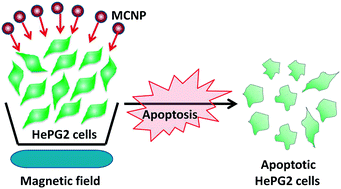Magnetic core–shell nanoprobe for sensitive killing of cancer cells via induction with a strong external magnetic field†
Abstract
The title system, composed of a highly magnetic core surrounded by a thin arsenite shell, has been synthesized and applied to the magnetically facilitated targeting of anticancer agent (sodium arsenite) in human hepatocellular liver carcinoma cells (HepG2) for exploiting arsenite at lower dose with minimal side effects and higher efficacy in a biocompatible manner. More specifically, we could achieve significantly higher apoptosis efficiency by targeting our sodium arsenite containing magnetic core–shell nanoparticles (MCNP) to HepG2 cells using an external magnetic field and a putative pathway was established on the basis of ROS (reactive oxygen species) generation assay, cell cycle analysis, mitochondrial membrane potential determination and nuclear localization of p53. This study first indicates the association of p53 with arsenic containing MCNP-induced hepatocellular apoptosis in the presence of an external magnetic field through modulation of specific signaling-pathways. This MCNP-based drug targeting method therefore can potentially be a powerful tool for the advanced treatment of various cancers.


 Please wait while we load your content...
Please wait while we load your content...